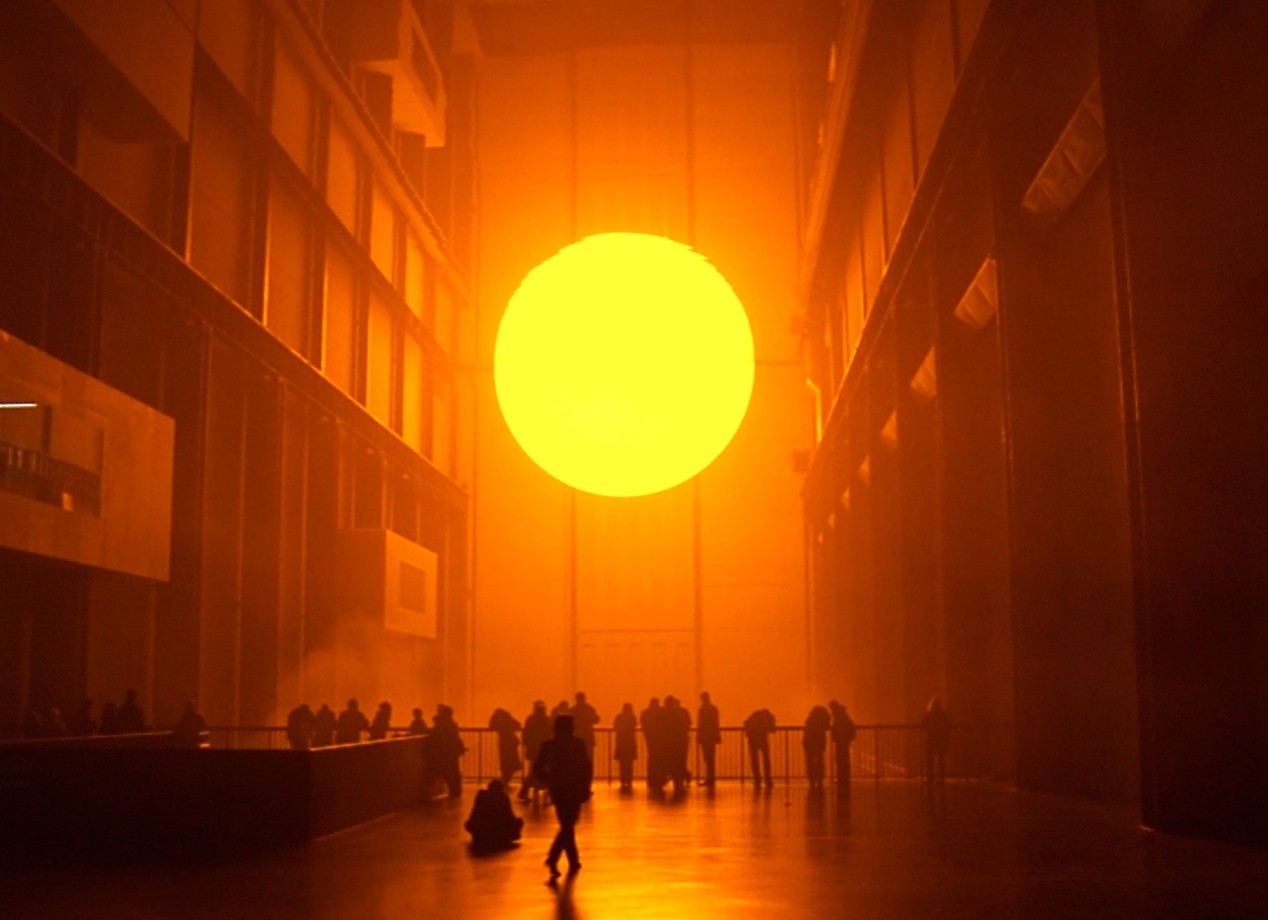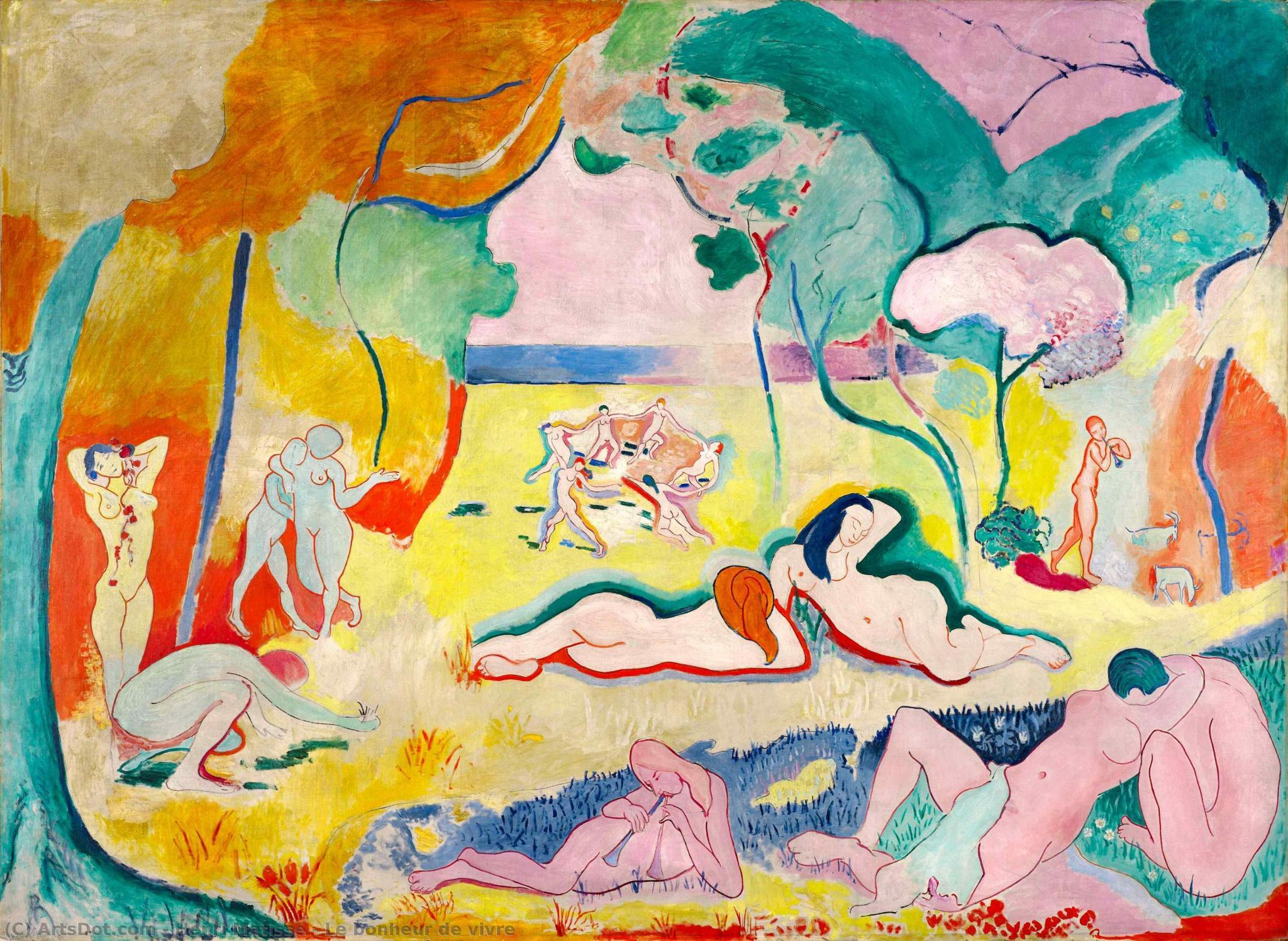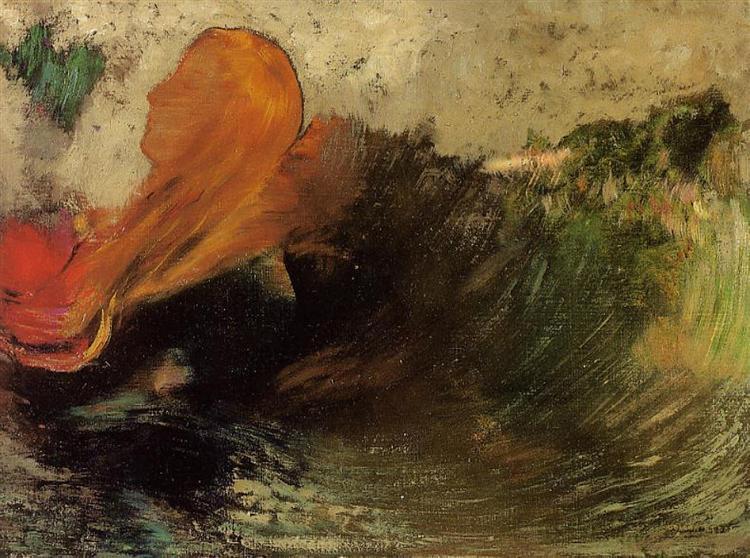Henri Matisse, The Joy of Life, 1905
Form:
-
Expressive, non-representational colour that
lacks explicit meaning
- Abstraction of proportion and scale
- Some non-representational forms
Content:
- A scene of only Female subjects
-
Representational of sensuality, pleasure,
and joy
- Set in a vibrant medow by the sea
Context:
-
A radical painting from the Fauvist movement
-
Influenced by Paul Cézanne’s final, Bathers,
from 1898-05
-
Directly inspired cubist artwork,
Demoiselles d’Avignon, from Picasso the
following year
Vincent van Gogh, Starry Night, 1889
Form:
-
Dynamic, swirling brushstrokes creating a
fluid sense of movement
-
Bold use of color with deep blues and
vibrant yellows
-
Emphasis on texture and surface through
thick application of paint (impasto)
Content:
-
Depicts a night sky over a small town with a
cypress tree in the foreground
-
Imaginative interpretation of the view from
the east-facing window of his asylum room at
Saint-Rémy-de-Provence
-
A blend of reality and van Gogh's emotional
state, conveying a sense of awe towards the
universe
Context:
-
Painted during van Gogh's time at the
Saint-Paul asylum in Saint-Rémy-de-Provence,
France
-
Represents van Gogh's fascination with the
nocturnal, the cosmos, and the divine
-
One of van Gogh's most celebrated works,
embodying his pioneering post-impressionist
style
Jacques-Louis David, The Oath of the Horatii, 1784
Form:
-
Clear, precise lines and stark contrasts to
emphasize drama and moral clarity.
-
Rational order, geometric composition, and
restrained palette.
-
Figures are idealized, drawing inspiration
from classical statues.
Content:
-
Depicts the Roman legend of the oath taken
by the Horatii brothers, symbolizing loyalty
and sacrifice for one's country.
-
Themes of duty, sacrifice, and patriotism.
-
A clear distinction between the masculine
world of civic virtue and the emotional
realm of women.
Context:
-
Exemplifies Neoclassicism, reflecting
Enlightenment ideals of reason, moral
virtue, and civic duty.
-
Commissioned by the French king, reflecting
the political climate and social ideals of
the late 18th century.
-
Influenced subsequent revolutionary ideals
and the aesthetic of the French Revolution.
Caspar David Friedrich, Wanderer above the Sea of Fog,
1818
Form:
-
Emphasis on emotion and individual
experience through dramatic landscapes and
moody atmospheres.
-
Use of light and shadow to create a sense of
mystery and sublime beauty.
-
Detailed textures and nuanced color palettes
to evoke the natural world.
Content:
-
A lone figure stands atop a mountain, gazing
into a fog-covered landscape, embodying
introspection and the sublime.
-
Represents man's contemplation of nature,
exploring themes of exploration, existential
reflection, and the sublime.
-
Interplay between the grandeur of nature and
human emotions.
Context:
-
Symbolizes the Romantic fascination with the
sublime aspects of nature and the
individual's emotional response to it.
-
Reflects the era's shift from Enlightenment
rationality to valuing emotion, intuition,
and the natural world.
-
Influences later movements that prioritize
individual perception and the emotional
impact of art.
Jean-François Millet, The Gleaners, 1857
Form:
-
Focus on realistic depiction of ordinary
scenes and subjects, with attention to
detail and naturalistic colors.
-
Composition highlights the physical strain
and dignity of the laborers.
-
Lack of idealization or romanticization of
the subject matter.
Content:
-
Depicts three peasant women gleaning
leftover grains after the harvest, a task
reserved for the poor.
-
Emphasizes the harsh realities of peasant
life and the social inequities of
19th-century France.
-
A sympathetic portrayal of the dignity of
labor and the plight of the working class.
Context:
-
Part of the Realism movement, which sought
to portray life accurately without
romanticizing or idealizing it.
-
Millet's work often focused on the lives of
peasants, highlighting the social issues of
his time.
-
The painting was controversial at its
unveiling, criticized by some for its
depiction of the working class.
Claude Monet, Impression, Sunrise, 1872
Form:
-
Loose, rapid brushstrokes capture the
fleeting effects of light and atmosphere.
-
Subtle shifts in color rather than detailed
forms convey the impression of the scene.
-
Foreground and background merge without
clear boundaries, emphasizing the momentary
impression.
Content:
-
Portrays the harbor of Le Havre at sunrise,
with the sun's reflection on the water and
silhouettes of ships.
-
Focuses on capturing the mood and atmosphere
of the scene rather than its details.
-
The title of the painting inspired the name
of the Impressionist movement.
Context:
-
Represents a pivotal moment in the
development of modern art, breaking from
traditional techniques and subjects.
-
Monet's work emphasizes the importance of
personal perception and the subjective
experience of nature.
-
Exhibited in the first Impressionist
exhibition in 1874, challenging the
conventions of fine art.
Odilon Redon, The Death of Ophelia, 1905
Form:
-
Evocative use of color and form to convey
emotion and narrative rather than realistic
depiction.
-
Dream-like quality achieved through soft,
fluid shapes and a muted color palette.
-
Combination of the real and the imaginary to
express deeper psychological truths.
Content:
-
Portrays Ophelia, a character from
Shakespeare's "Hamlet," in her tragic final
moments surrounded by nature.
-
Themes of beauty, death, and the
transcendence of the soul through symbolic
elements.
-
Focus on the emotional and mystical rather
than the literal scene, inviting personal
interpretation.
Context:
-
Reflects the Symbolist movement's interest
in exploring themes of mythology, dreams,
and the human psyche.
-
Redon's work often delves into the realm of
fantasy, using literature and myth as
sources of inspiration.
-
Challenges the conventions of naturalism and
realism, favoring personal symbolism over
objective reality.
Pablo Picasso, Les Demoiselles d'Avignon, 1907
Form:
-
Breakdown of forms into geometric shapes,
challenging traditional perspectives.
-
Fragmentation of the human figure and space,
suggesting multiple viewpoints
simultaneously.
-
Use of sharp angles and intersecting planes
to create a sense of depth and volume.
Content:
-
Depicts five nude female prostitutes from a
brothel on Carrer d'Avinyó in Barcelona.
-
Combines Iberian and African art influences
with avant-garde theory, challenging
traditional European painting.
-
Marks a radical departure from traditional
composition and perspective, heralding the
birth of Cubism.
Context:
-
Regarded as a revolutionary work that
inaugurated the Cubist movement,
fundamentally altering the course of modern
art.
-
Reflects Picasso's interest in non-Western
art forms and his search for a new way of
seeing.
-
Provoked controversy and debate, with its
avant-garde approach influencing generations
of artists.

Marcel Duchamp, Fountain, 1917
Form:
-
Readymade sculpture, utilizing a
mass-produced urinal turned on its back.
-
Minimal alteration by the artist,
challenging traditional notions of
craftsmanship and artistry.
-
Emphasis on the idea behind the work rather
than its aesthetic value or technical
execution.
Content:
-
A radical challenge to the art
establishment, questioning what constitutes
art and the role of the artist.
-
Symbolizes the rejection of conventional
aesthetic criteria and the commercialization
of art.
-
One of the most iconic examples of Dadaism,
embodying the movement's interest in irony,
absurdity, and disillusionment.
Context:
-
Submitted to the Society of Independent
Artists exhibition in 1917 under the
pseudonym "R. Mutt."
-
Dadaism emerged in response to the horrors
of World War I, promoting anti-war,
anti-art, and anti-establishment ideas.
-
Duchamp's work profoundly influenced
conceptual and contemporary art, emphasizing
the idea or concept over traditional
aesthetic and material concerns.
Salvador Dalí, The Persistence of Memory, 1931
Form:
-
Detailed, realistic rendering with
dream-like, bizarre imagery that defies
logical explanation.
-
Soft, melting pocket watches contrast with
the hard, permanent landscape, challenging
perceptions of reality and time.
-
Use of sharp, precise detail to create a
surreal dream world.
Content:
-
Explores the theme of time's relative and
distorted nature within the subconscious and
dream states.
-
Features a desolate landscape with melting
clocks, a dead tree, and the bizarre figure
in the center, often interpreted as a
self-portrait of Dalí's face.
-
Combines the ordinary with the fantastical,
inviting multiple interpretations and
emotional responses.
Context:
-
One of Dalí's most famous works, emblematic
of the Surrealist movement's exploration of
the unconscious mind.
-
Reflects Surrealism's interest in dreams,
psychoanalysis, and the irrational aspects
of the human psyche.
-
The work's iconic status has made it a
crucial reference point in both art history
and popular culture.
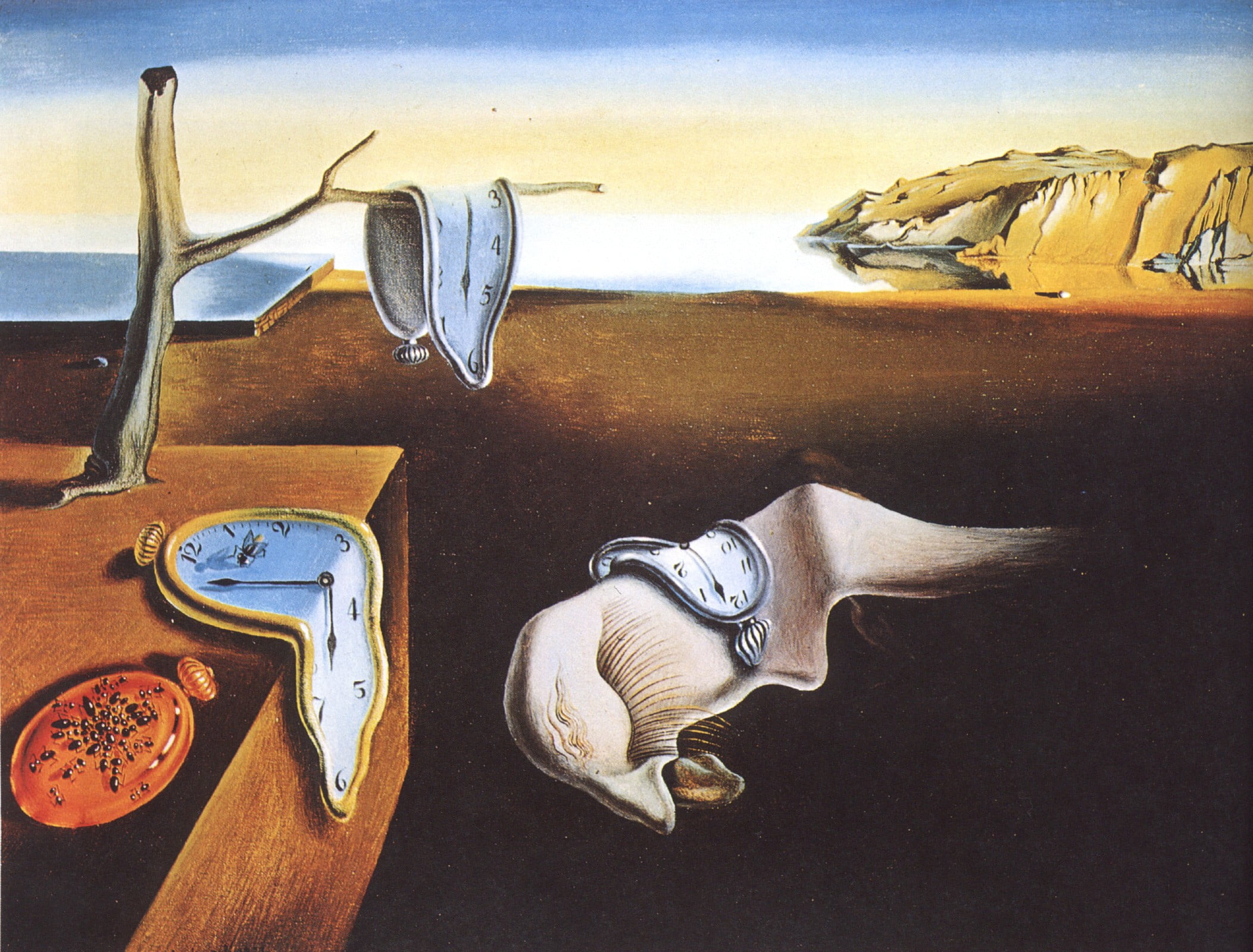
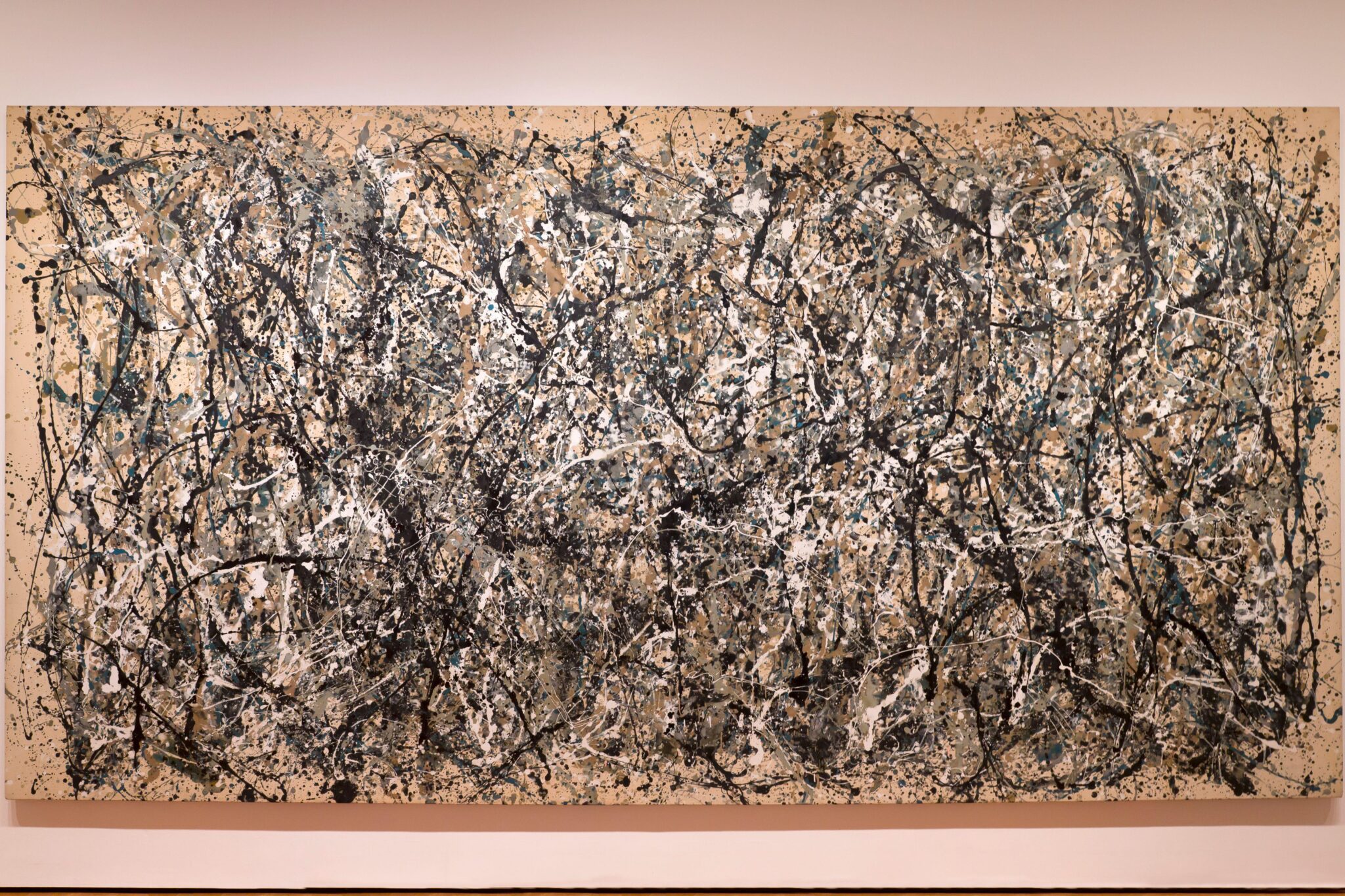
Jackson Pollock, Autumn Rhythm (Number 30), 1950
Form:
-
Characteristic of Pollock's "drip"
technique, where paint is dripped or poured
onto the canvas.
-
Abstract composition with no central focus,
emphasizing the texture and movement of
paint.
-
Dynamic interplay of lines, shapes, and
colors creates a sense of rhythm and motion.
Content:
-
Represents Pollock's exploration of painting
as an act of expressing the unconscious.
-
Engages viewers on an emotional level,
inviting them to navigate the canvas's space
and interpret its forms and movements.
-
No representational content, focusing
instead on the act of creation and the
materials used.
Context:
-
Part of the Abstract Expressionist movement,
which emphasized spontaneous, automatic, or
subconscious creation.
-
Pollock's innovative techniques marked a
departure from traditional painting methods,
influencing the direction of modern art.
-
The work reflects the post-World War II
sentiment, embodying freedom of expression
and the complexity of the human psyche.
Andy Warhol, Marilyn Diptych, 1962
Form:
-
Consists of 50 images of Marilyn Monroe,
half in color and half in black and white,
utilizing silkscreen printing techniques.
-
Repetition of the iconic image reflects
themes of mass production and
commodification in popular culture.
-
The contrast between the vivid color and the
faded black and white images suggests the
dichotomy between the celebrity's public
persona and her private struggles.
Content:
-
Depicts Marilyn Monroe, an iconic figure of
popular culture, exploring themes of fame,
mortality, and media saturation.
-
The work's repetitive nature comments on the
mass production and consumption of celebrity
images.
-
Reflects on the transient nature of fame and
the commodification of individuals.
Context:
-
Created shortly after Marilyn Monroe's
death, highlighting the media's role in
shaping her public image and the impact of
her untimely demise.
-
Warhol's work is central to the Pop Art
movement, which emerged as a response to the
burgeoning consumer culture and the
proliferation of media imagery.
-
The piece is a critical reflection on the
artifice of fame and the cultural obsession
with celebrity.


Donald Judd, Untitled, 1969
Form:
-
Features a series of identical, spaced,
rectangular forms made of industrial
materials like steel, aluminum, or
Plexiglas.
-
Emphasizes simplicity, geometric shapes, and
the use of materials without ornamentation.
-
Installation and space become integral parts
of the artwork, inviting viewers to consider
the relationship between the objects, the
space, and themselves.
Content:
-
The work's content is its form; it does not
represent or symbolize anything outside of
its physical presence.
-
Challenges traditional notions of sculpture
and painting by presenting objects as direct
expressions of their material and form.
-
Encourages a focus on the viewer's
experience of space, form, and material.
Context:
-
Part of the Minimalism movement, which
reacted against the emotional excess of
Abstract Expressionism and the commercialism
of Pop Art.
-
Judd's work exemplifies the minimalist ethos
of reducing art to its essential qualities
and eliminating personal expression.
-
The use of industrial materials and methods
reflects a democratic approach to art,
emphasizing clarity and objectivity.
Olafur Eliasson, The Weather Project, 2003
Form:
-
Large-scale installation in Tate Modern's
Turbine Hall featuring a semi-circular form
made of hundreds of mono-frequency lamps.
-
The ceiling of the hall was covered with a
giant mirror, allowing visitors to see
themselves as tiny reflections beneath the
artificial 'sun'.
-
Utilizes light and mirrors to create an
immersive environment, playing with
perceptions of space and self.
Content:
-
Engages with themes of nature, perception,
and the human experience in urban
environments.
-
Simulates a setting sun, creating a shared,
communal space within the museum setting.
-
Invites contemplation on the impact of
weather on individual mood and collective
behavior.
Context:
-
Eliasson's work is part of a broader
movement in contemporary art that emphasizes
experiential, immersive installations.
-
Reflects the increasing concern with
environmental issues and the role of art in
social and ecological discourse.
-
The installation was a landmark event in the
early 2000s, drawing millions of visitors
and sparking wide discussion on the
relationship between art, environment, and
technology.
